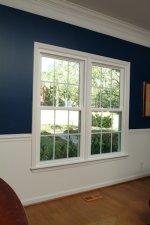Double-Hung Windows: The Popular Choice
Seaway Manufacturing of Erie, PA,
When it comes to the form factor of your replacement windows, there are plenty of options including casement windows, sliding windows, awning windows, bays, bows and more. But far and away the most popular choice is the double-hung window. What should you look for in a double-hung and why? Read on.
First, the name “double hung” simply means that both the top and bottom sash of the window
If your home already has double-hung windows, and chances are pretty good that it does, you’ll probably replace them with the same type. (There are situations where you may want to consider other options, and we’ll address those in future posts.) Here’s what you can expect:
Easy cleaning: It used to be that when you wanted to clean the outside of your upstairs windows you’d have to get on a ladder. No more … both sashes on just about all modern double-
Insulated glass: Each sash will have at least two panes of glass, sometimes three, with a sealed airspace in between for better insulating efficiency than your old single-pane windows
Security: All but the narrowest windows should have two sash locks. Besides the obvious security benefit of a locked window, these locks pull the sashes together at the meeting rail for a tighter fit and better resistance against wind. The lesson: lock your windows even if they’re not reachable from the ground. Look for an interlock between the top and bottom sash, important for both security and to protect against air infiltration.
Venting: Better windows will also feature vent locks, which will fix the window in a partially open position but keep it from being opened further. This allows you to let in the fresh air without the fear of an intruder being able to enter your home through the opening. Locking the sash in a partially open position also minimizes the risk of a fall by a child or pet.
Screens: A screen is a screen, right? Not quite. Screening material can vary significantly from one window to another. A screen’s primary purpose is to keep bugs out, of course, but better screens will do two more things: maximize
Lift Rail: This is simply the part you grab to raise or lower the bottom sash. There’s not a lot to it, except that on lower-end windows the lift rail can have a pretty flimsy feel to it. Look for a lift rail that’s an integral part of the sash, not snapped on or glued in after the fact. These will be more durable and longer-lasting. Be sure to actually operate any window you’re considering and make sure it’s sturdy.
Questions about replacement windows? Contact Seaway Manufacturing, or click here to find a Seaway dealer in your area



